The exhibits of the Aurora History Museum, located outside the Historian's Office and presented in collaboration with the Aurora Historical Society, are open during Municipal Center hours, 8:30 a.m.-4:30 p.m., Monday through Friday, except holidays. The Municipal Center is located at 575 Oakwood Avenue in East Aurora.
Past Featured Exhibitions
In addition to the permanent historical exhibits at the Aurora Municipal Center, temporary Featured Exhibitions have highlighted artifacts and documents in the collections of the Aurora Town Historian's Office and Aurora Historical Society, as well as unique aspects of our community’s history.
Below are highlights of our past Featured Exhibitions:

Happy Birthday, East Aurora!
February 5 - June 7, 2024
The Village of East Aurora turns 150 years old in 2024!
In the early 1800s, New York State began allowing higher-populated hamlets within towns to incorporate as villages, to provide enhanced government services, such as sidewalks, street lamps, garbage collection and police departments.
In 1836, the Village of Auroraville was incorporated by the State of New York to bring together the eastern and western hamlets of what is today the Village of East Aurora. After a dispute with the state over the name (local residents wanted to be the Village of Aurora without the -ville) the Village of Auroraville all but disappeared after about a year. More than a decade later, in 1849, the residents of the hamlet at the western end incorporated as the Village of Willink, a name that comes from Wilhelm Willink, an early principal of the Holland Land Co.
After the Civil War, another movement to merge the eastern and western ends of the community under one village government began to gain traction. In January 1874, the boundaries of the Village of Willink on the western end were extended to include the eastern end.
State and county officials then allowed local residents to decide whether to keep the name Willink or reincorporate as East Aurora, the name of the post office on the eastern end since 1850.
By 19 votes, in an election on June 2, 1874, the residents decided to change the name: 122 voted in favor of East Aurora; 103 chose Willink. And with that, the Village of East Aurora was born!
With artifacts, newspapers and documents from the archives of the Aurora Town Historian’s Office, this exhibit took a look back at the “Centelebration” held 50 years ago, in 1974, to commemorate the Village of East Aurora’s 100th anniversary. A giant parade, beard-growing contest, carnival, Miss Centelebration contest and other special events were held to celebrate “Five Score in ‘74.”
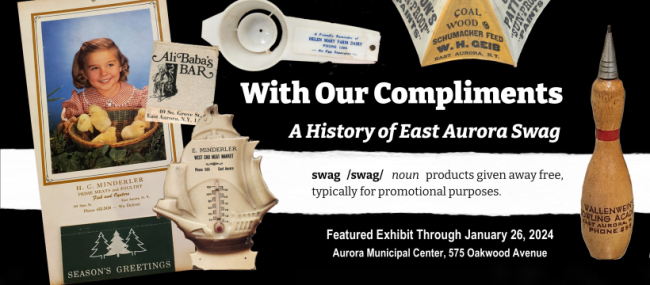
With Our Compliments:
A History of East Aurora Swag
September 25, 2023 - January 26, 2024
Swag might be a modern term, but businesses have been giving away promotional products for more than a century. Collected in this special exhibit are just some of the East Aurora “swag” preserved in the archives of the Aurora Town Historian’s Office and in the collection of the Aurora Historical Society.
Local businesses seemed to never miss an opportunity, particularly at Christmastime, to offer a token of appreciation to their customers that just so happened to include the business’s name and/or logo: Everything from a spoon that served as a “stirring reminder” of Fox’s Delicatessen to calendars, pens, memo books, pocket mirrors, thermometers, yard sticks, rulers and matchbooks. In addition to offering free products, businesses also have a long history of adding their names to the merchandise.

We'll Ne'er Forget Our High School Days:
The Yearbooks of East Aurora
June 5-September 8, 2023
All thanks to donations from graduates and their families, the collection of East Aurora High School yearbooks in the archives of the Aurora Town Historian’s Office dates back to the earliest days of the East Aurora Union School District in the 1880s. The East Aurora High School "yearbook" has taken many forms throughout the years, and it hasn’t always been called the Auroran. It has evolved from a brochure-sized school “catalogue,” to the “Senior Number” of the high school student magazine each June to the more modern high school yearbook of today.
Regardless of its name or format, the annual yearbook has become an important historical record of East Aurora High School and all those who attended it.
This exhibit featured many of the East Aurora High School yearbooks from our collection.

The Shapes of the Circle
January 20-May 31, 2023
To improve transportation in recent years, traffic engineers have converted intersections to roundabouts in many Erie County communities. In East Aurora, however, this innovation is nothing new.
“The Circle” has been an unofficial landmark in East Aurora since 1936, but folks might be surprised to learn that it hasn’t always been a circle. And although it is officially known as Willink Square, named after the village that once surrounded it, it’s never been a square.
It started out in the early 1800s as nothing more than a dirt convergence of some of East Aurora’s main roads. It later became informal ovals, then grass triangles, and—after automobiles grew in popularity—the intersection was converted into a circle as part of a Depression-era Works Project Administration initiative in 1936. Though transportation engineers consider it a “roundabout,” folks in East Aurora simply call it “The Circle.”
This exhibit invited viewers to take a look around at the history of The Circle’s many shapes over the years.
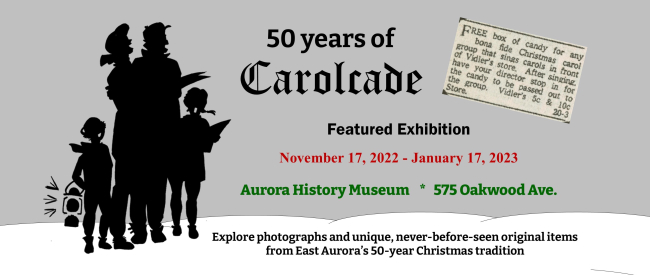
50 Years of Carolcade
November 17, 2022-January 17, 2023
In commemoration of East Aurora's 50th Christmas Carolcade on December 17, 2022, this exhibit featured photographs and unique, never-before-seen original items from the first 49 Carolcades, gathered from the Vidler family, the archives of the Aurora Town Historian’s Office and the personal collection of Town Historian and Carolcade master of ceremonies Robert Lowell Goller.
A History of Carolcade
Click here to learn more about the history of this unique community event.

Read All About It!: A History of East Aurora’s Newspapers
August 11-November 15, 2022
Most of East Aurora’s more than 20 newspapers dating back to 1835 were short lived. In commemoration of the East Aurora Advertiser’s 150th anniversary, original editions of East Aurora’s newspapers over the years—some of them very rare—were curated from the archives of the Historian’s Office and donated from private collections. Our goal was to have an original copy of every newspaper published in the Town of Aurora. We are missing just a few.
Community Newspapers are an Invaluable Historical Resource
East Aurorans rely on the Advertiser for local news. But in the Town Historian’s Office we rely on it for local history. In honor of the East Aurora Advertiser's 150th anniversary, Historian Robert Lowell Goller shared in a newspaper column a few reasons why community newspapers are nearly always the first stop on any research journey.
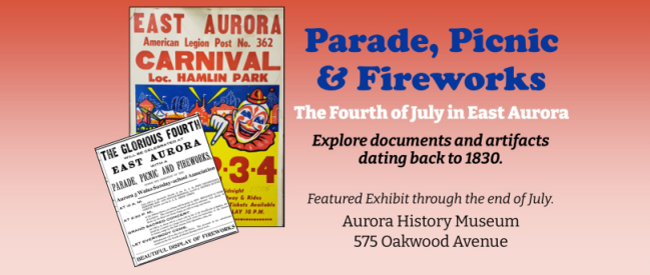
Parade, Picnic & Fireworks: The Fourth of July in East Aurora
June 2-July 31, 2022
Independence Day observances in the Town of Aurora can be documented as early as 1830, and they were most likely held even earlier. In this exhibit, we featured just some of the artifacts from the archives that symbolize the evolution of the local event over the years, from a short procession, speeches and the recitation of the Declaration of Independence in the 1830s; to the Hamlin Park carnival of the mid 1900s; to the “old-fashioned” celebration of today.
For more details about the history of the Independence Day in East Aurora, explore these documents from the archives of the Aurora Town Historian's Office, as well as previously published newspaper columns by the Town Historian:
Recollections of Independence Day, 1830
Local educator George W. Jonson kept a journal, from which we know details about East Aurora’s Independence Day celebration in 1830. It took place on July 5 because the Fourth was on a Sunday. East Aurora did not have its first newspaper until five years later, so Jonson’s diary is the only way we know what happened.

The Diary: Two Centuries of Written History
April 6-May 31, 2022
We know what happened in East Aurora in 1873 because 21-year-old Helen F. Persons kept a diary. And we know details about the construction of the house at 110 Pine Street in 1878 and 1879 because its first owner, Dwight Spooner, kept a journal. These are just two of the many diaries preserved in the archives of the Historian’s Office and featured in this exhibit. Diaries provide accounts of marriages, deaths and births that were not always documented elsewhere.
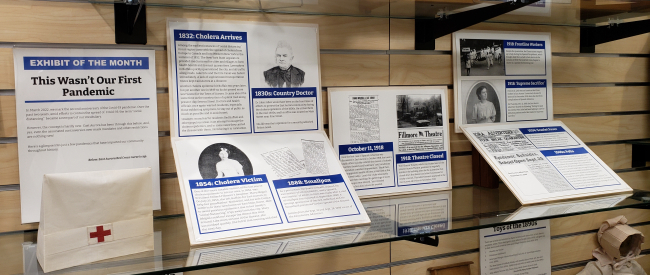
This Wasn’t Our First Pandemic
February 23-April 4, 2022
March 2022 marked the second anniversary of the beginning of the Covid-19 pandemic. The term “social distancing” became a new part of our vocabulary. However, the concept is hardly new. East Aurora has been through this before. And, yes, even the associated controversies over mask mandates and other restrictions are nothing new! This exhibit offered an updated glimpse into just a few pandemics that have impacted our community throughout history.
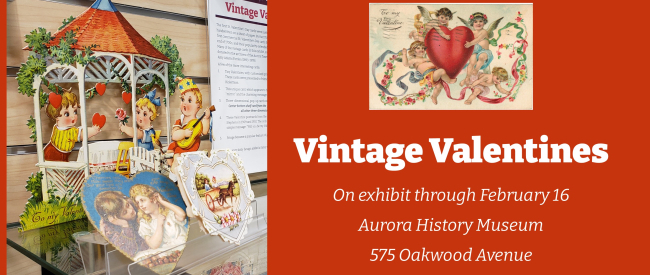
Vintage Valentines
January 7-February 17, 2022
Many of the cards in this special exhibit, some more than 100 years old, were donated to the archives of the Aurora Town Historian’s Office by former Historian Amy Adams Forden (1893-1978). They include three-dimensional greetings, postcards and cards with fringe, which was a popular feature in the late 1800s. One unique card even features a mirror!
